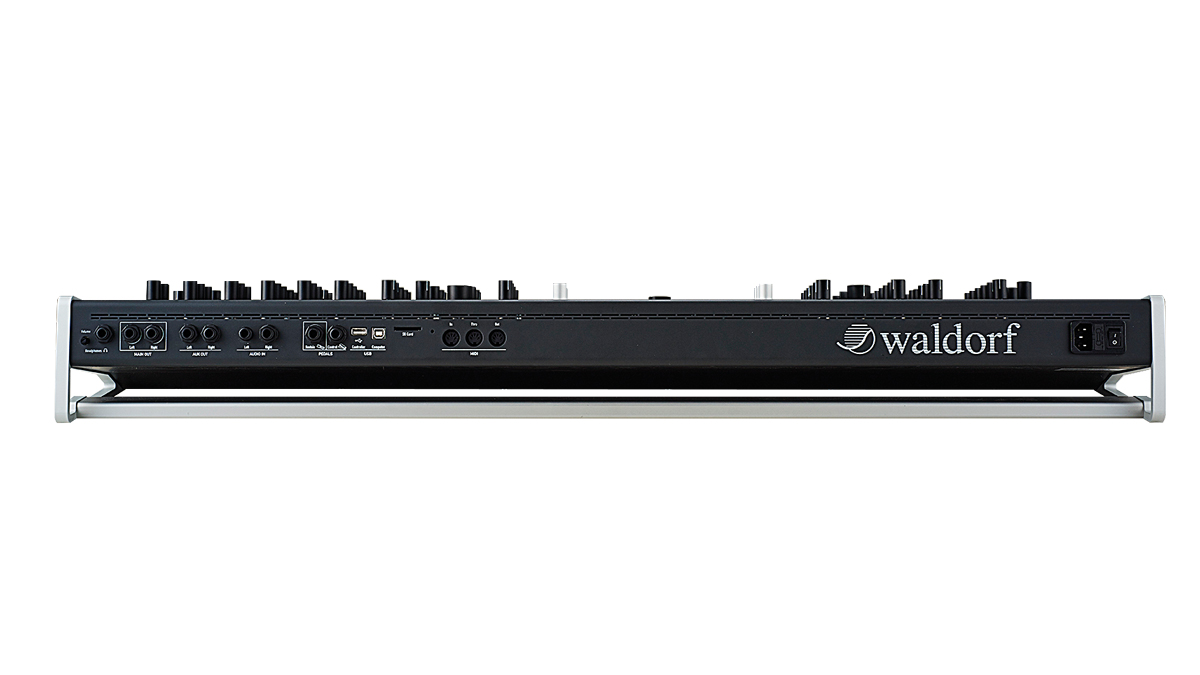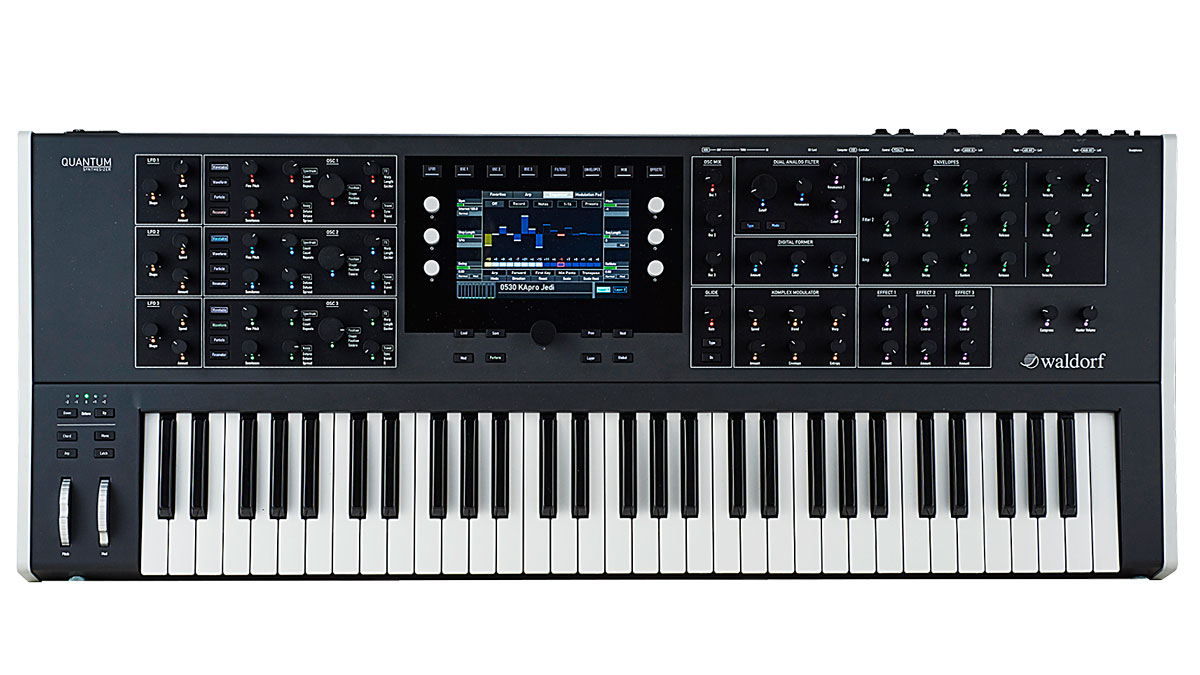MusicRadar Verdict
A stunning piece of hybrid synth design - the Quantum has set a new benchmark in terms of features, interface and sonics.
Pros
- +
Built like a tank, with solid controls, clear and snappy touchscreen and beautiful graphics.
- +
Spec’d to the hilt!
Cons
- -
No multimode for the analogue filter (though the Digital Former makes up for this).
- -
Certain select boxes are a little narrow onscreen.
MusicRadar's got your back
From the beastly Wave through to its Nave and Largo software instruments, to the Studiologic Sledge, Blofeld and Pulse series, Waldorf never do the norm when it comes to the synths!
However, it hasn’t had a wow-factor flagship for a while and although it teased the Stromberg a few years back, it never came to fruition. Fast-forward to 2018 and Waldorf have its flagship Quantum and it looks and feels stunning.
Designed by the industrial design gurus at Design Box (led by Axel Hartmann), whatever angle you view the Quantum from it impresses, whether that be the moody charcoal grey metal case, the beautiful silver aluminium framing/trim which runs along the sides and back or the lovely flush/aged wood inserts on each side. Then you have the black/silver aluminium dials with colour-coded multicolour LEDs to link sections and keep things clear on the front panel. Everything is laid out very cleanly and logically with the LFOs together, then the three oscillators, main control and performance section with central touchscreen, sound shaping areas (Dual Analogue Filter, Digital Former, Komplex Modulator) then envelopes and effects.
It all flows very smoothly and it’s surprisingly logical to work with - you really get drawn into making sounds as the work flow is very engaging and importantly, very tactile. You can exclusively use the front panel controls when sound designing and not even involve the screen but if you really want to get deeper you can use the screen and its corresponding surrounding silver knobs to instantly tweak deeper parameters.
There’s clearly been a lot of thinking about how to make such a complex machine intuitive and that has really paid off here (especially helpful are the main mode buttons above the screen which take you to the main editing sections). Consequently, anyone can power up Quantum and be making and tweaking sounds instantly (in many ways, the Quantum reminds me of the Alesis Andromeda A6, in as much as it feels like a modular synth in a box, although this is a hybrid machine vs the VCO-driven A6). Whilst on the interface tip, we must mention that the touchscreen is magnificent - it’s snappy in use, very clear and the colours and displays are beautiful. My only criticism is that some parameter boxes are a little narrow and can become obscured by your finger - perhaps an ‘instant zoom’ could be added in an update.
Let’s now take a quick look at the more straightforward stuff. To the left of the keyboard you have standard performance controls including beautifully weighted metal pitch and mod wheels, along with controls for the nicely spec’d arpeggiator and a Chord button which is basically a hold button - play a chord, hit Chord and the chord will hold until you play another chord or note. This allows you to tweak the numerous parameter dials with both hands, which for a tactile synth like this is very welcome! The keyboard utilises a high-quality Fatar TP8S keybed and it feels great - perfectly weighted for fast/more detailed playing with predictable response in all situations and for all styles of playing, plus the aftertouch implementation is spot on – not too hard or easy to trigger. Alas, there’s no poly-aftertouch available natively but the Quantum will at least receive poly AT messages and it also receives/ transmits MIDI messages via its front panel controls (most parameters can be controlled over MIDI).

At its heart, the Quantum is an 8-voice, bi-timbral (2-part) synth, using very high-resolution stereo oscillators routed through dual resonant analogue (or digital) filters. Sounds can be split and layered and voices can be allocated flexibly between layers; each layer can also have its own output for independent processing. Importantly, there are four independent synthesis engines (across the three oscillators) which we’ll now explain as simply as we can...
First off, there’s Wavetable mode which allows you to work with the preset/user wavetables (wavetables are basically single waves made up of several pieces of audio, which can then be modulated). The Quantum allows very complex wavetable modulation for seemingly constantly evolving sounds, plus you can import your own via SD card. You can cycle through the wavetables in many radical ways using the Travel parameter or set the position the wavetable starts at when you press a key, change the harmonic spectrum, get the Quantum to speak typed words and much more besides. With just one wavetable oscillator (and using the many onboard parameters plus modulation), Wavetable mode is capable of vastly complex shifting and evolving sounds.
Next you have Waveform mode which utilises familiar, classic waves (stereo/digital) but, with this being the Quantum, there’s more to it! The waves sound super-precise yet warm and present and in addition to the standard oscillator waves (saw, sine triangle, noise etc) you have further ‘kernels’ (up to eight additional oscillators stacked against the main oscillator wave) which form super-waves. These kernel oscillators can then be detuned to form massive ‘super-osc’ sounds, with panning of the oscillators available across the stereo-spectrum too. This is in addition to the Unisono mode (unison detune). You’ll also find common performance parameters such as glide, legato, multi-trigger, PWM, sync and more.
The next mode is Particle mode, which uses samples for its core sounds. Samples can be recorded via the rear inputs, imported via SD card or you can start with the excellent onboard samples instead. Samples can be easily auto-mapped and very deep ‘granular’ editing of samples is available too; you can get some awesome grainy sounds happening from just one note of a piano sample (for example), especially when modulating one or more of the many available sound-shaping parameters. You can tweak the length of the grains within any sample along with pitch, spread, position jitter (randomisation), grain polyphony, attack, decay, ping-pong behaviour (you get the idea)...
The Quantum features a Komplex Modulator, best described as a complex LFO. Set it as a mod target to one or more destinations, turn the controls and let the fun begin! You have parameters including speed, warp, entropy (random noise/disorder) and envelope to play with and it’s an instant way to spice up any sound, creating evolution, texture and grit. You can create different curves onscreen too and have smooth or stepped changes happen.
Next, you have a versatile 32-step sequencer (with swing), which can be directed to notes/velocity and also to four further modulation destinations. Pitch, note velocity and note length are editable, the sequence can be key-triggered at different pitches, plus there are five direction modes (including ping-pong and forwards/backwards). It’s a handy writing/ideas tool and can be synced with the arpeggiator and Komplex Modulator too.
The 7-mode arpeggiator shares many of the sequencer’s parameters. In addition, it also includes chord and random modes, order sorting by velocity and more besides. All these features add up to the overall feel of ‘anything is possible’ with this machine... inspiring stuff!
There’s a dizzying amount of control and deep particle- level granular tweakability! With this mode, Quantum can become as big as your imagination and it’s worth importing various types of audio and/ or resampling the Quantum itself and seeing what results you get. To get fully acquainted, start with the included samples as it does take time to learn the work flow but the results are well worth the effort.
The final mode is Resonator. Like Particle mode, you can use samples as your initial sound source (called an Exciter) but this time, a noise impulse is fed through a band-pass-resonant-filter bank. This noise impulse can be resized and split into partials to achieve different evolving/modulated/ mutating timbral variations. Partials can be repeated (up to 16 times) and spread, stretched and stiffened, whilst there are also five ‘timbre’ modes including sin-saw and saw-square (to give you an idea of the tonality). Alone, this Resonator engine is capable of classic digital sounds (and it also does mean linear FM- sounding and analogue impressions) along with more twisted stuff. Couple this with the Quantum’s extensive mod routes/facilities, dual-analogue filters, six LFOs, six loopable envelopes, plus the Digital Former and the possibilities feel endless.
Filter-wise, Quantum features a dual-analogue self-oscillating low-pass filter (with 12/24dB slopes) and it sounds great - warm and lush yet precise with a liquidy resonance/ sheen. There are four types of low-pass filter (including saturated/ driven versions) and eight configurations which link the filters differently for different sonics. There are independent cutoff and resonance controls for each filter and, in addition, the Digital Former includes digital filter modes such as comb, HP, BP, Notch, bitcrusher and drive, plus filters from Waldorf’s own Nave/Largo software plugins and PPG hardware (the routing between the analogue filters and Digital Former can be tweaked for further sonic exploration).
We’ve only touched upon what this mega-synth is capable of. It is truly unique and capable of stunning, otherworldly, or familiar sonic results. It can sound huge, small, thin, fat, warm, epic, broken or cold and you can imprint your personality onto the sound using the available parameters, or your own samples. For ground-up, majestic sound design, SFX for lm/TV, weird evolving soundscapes, straight-up analogue synth emulation, FM-type sounds, and eery FX/atmos sounds, the Quantum is unbeatable. Yes, it’s pricey but it’s worth the investment - you’ll never get bored with this amount of depth and superb sonic results. Best get saving!
“Excels at unique modulated timbres, atonal drones and microtonal sequences that reinvent themselves each time you dare to touch the synth”: Soma Laboratories Lyra-4 review
“I used everything I knew about music”: How Green Day exceeded expectations with their most ambitious song
YouTube just added AI tools that makes musicians, library music and video editors redundant










